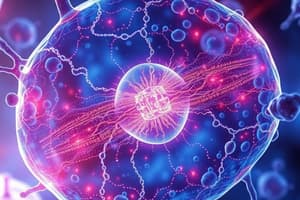Podcast
Questions and Answers
What is the primary function of membrane receptors?
What is the primary function of membrane receptors?
- To provide structure to the cell membrane
- To synthesize proteins
- To bind to specific extracellular molecules and cause a corresponding cellular response (correct)
- To facilitate the passage of molecules through the membrane
What is the typical composition of membrane-spanning components of membrane receptors?
What is the typical composition of membrane-spanning components of membrane receptors?
- Alpha helices (correct)
- Cytoplasmic organelles
- Beta sheets
- Beta barrels
What is the function of ligands in cellular signaling?
What is the function of ligands in cellular signaling?
- To provide structure to the cell membrane
- To facilitate the passage of molecules through the membrane
- To bind to receptors to produce an intercellular signal (correct)
- To synthesize proteins
What is the purpose of channels in cellular membranes?
What is the purpose of channels in cellular membranes?
What is the composition of channels in cellular membranes?
What is the composition of channels in cellular membranes?
What is the function of the cytosol in cellular structure?
What is the function of the cytosol in cellular structure?
What type of amino acids would be present in the intramembranous domains of membrane receptors?
What type of amino acids would be present in the intramembranous domains of membrane receptors?
What type of amino acids would be present in the intra- and extracellular domains of membrane receptors?
What type of amino acids would be present in the intra- and extracellular domains of membrane receptors?
What is the unit of osmotic pressure?
What is the unit of osmotic pressure?
Which of the following increases the osmotic pressure of a solution?
Which of the following increases the osmotic pressure of a solution?
What is the role of van't Hoff factor in osmotic pressure?
What is the role of van't Hoff factor in osmotic pressure?
What is the primary purpose of the plasma membrane in a cell?
What is the primary purpose of the plasma membrane in a cell?
What is the characteristic of phospholipids that allows them to form a lipid bilayer?
What is the characteristic of phospholipids that allows them to form a lipid bilayer?
In which direction will water flow when a cell with a higher osmotic pressure is placed in a solution with a lower osmotic pressure?
In which direction will water flow when a cell with a higher osmotic pressure is placed in a solution with a lower osmotic pressure?
What is the purpose of facilitated diffusion in a cell?
What is the purpose of facilitated diffusion in a cell?
What is the function of cholesterol in the plasma membrane of eukaryotic cells?
What is the function of cholesterol in the plasma membrane of eukaryotic cells?
What is the term for areas in the plasma membrane with high concentrations of cholesterol?
What is the term for areas in the plasma membrane with high concentrations of cholesterol?
What is the driving force behind spontaneous movement of molecules?
What is the driving force behind spontaneous movement of molecules?
What is the main difference between peripheral and integral proteins in the plasma membrane?
What is the main difference between peripheral and integral proteins in the plasma membrane?
Which of the following is an example of facilitated diffusion?
Which of the following is an example of facilitated diffusion?
What will happen to a cell placed in a hypertonic solution?
What will happen to a cell placed in a hypertonic solution?
What is the term for proteins that span the entire plasma membrane and have both extracellular and intracellular domains?
What is the term for proteins that span the entire plasma membrane and have both extracellular and intracellular domains?
Why do prokaryotes not use cholesterol in their plasma membrane?
Why do prokaryotes not use cholesterol in their plasma membrane?
What is the term for the smallest unit of self-sustainable life?
What is the term for the smallest unit of self-sustainable life?
What is the result of the hydrolysis of ATP?
What is the result of the hydrolysis of ATP?
What is the primary source of energy for biological reactions?
What is the primary source of energy for biological reactions?
What is the function of Na+/K+ ATPase?
What is the function of Na+/K+ ATPase?
What is the purpose of secondary active transport?
What is the purpose of secondary active transport?
What type of amino acids would be present in the core of a Ca2+ channel?
What type of amino acids would be present in the core of a Ca2+ channel?
What is the process of releasing cellular contents into the extracellular environment?
What is the process of releasing cellular contents into the extracellular environment?
What is the energy yield of ATP hydrolysis?
What is the energy yield of ATP hydrolysis?
What is the purpose of active transport?
What is the purpose of active transport?
What is the primary function of endocytosis in a cell?
What is the primary function of endocytosis in a cell?
What type of transport is exocytosis and endocytosis an example of?
What type of transport is exocytosis and endocytosis an example of?
What is the name of the protein used to create vesicles in exocytosis and endocytosis?
What is the name of the protein used to create vesicles in exocytosis and endocytosis?
What is the main difference between symport and antiport transportation?
What is the main difference between symport and antiport transportation?
What is the purpose of symport and antiport transportation?
What is the purpose of symport and antiport transportation?
What is the term for vesicles produced in exocytosis?
What is the term for vesicles produced in exocytosis?
Flashcards are hidden until you start studying
Study Notes
The Cell
- The cell is the smallest unit of self-sustainable life.
Plasma Membrane
- Composed of a lipid bilayer, separating external and internal environments to maintain homeostasis.
- Phospholipids have an amphipathic nature, with a charged phosphate head and hydrocarbon tails.
- Cholesterol is used by eukaryotes to maintain consistency in membrane performance at various temperatures.
- Lipid rafts are areas in the membrane with high concentrations of cholesterol, surrounding proteins or other membrane components.
Proteins
- Peripheral proteins attach to one side of the membrane, either externally or internally.
- Integral proteins, also called transmembrane proteins, span the entire membrane with both extracellular and intracellular domains.
- Membrane receptors are integral proteins that bind to specific extracellular molecules, causing a corresponding cellular response.
- Channels allow for the passage of molecules through the membrane, composed of beta barrels, and each type allows passage of a different substance.
Cytoplasm
- The entire interior of the cell, including organelles and cytosol.
- Cytosol is the gel-like portion suspending organelles, composed of water, ions, proteins, etc.
Osmotic Pressure
- The pressure needed to prevent the inward flow of water from a pure solution across a semipermeable membrane.
- Described by the equation: π = iMRT, where π is the osmotic pressure, i is van't Hoff's factor, M is the molarity of the solution, R is the ideal gas law constant, and T is the temperature in Kelvin.
Facilitated Diffusion
- Passage of polar molecules or charged ions through a protein channel or carrier.
- Molecules move from areas of high concentration (or charge) to areas of low concentration (or charge), down an electrochemical gradient.
Active Transport
- Energy is used to move solutes against their electrochemical gradient.
- ATP is the primary source of energy for biological reactions, produced by the cell.
- Na+/K+ ATPase pumps 3 Na+ ions out of the cell and 2 K+ ions into the cell, against their chemical gradients.
Exocytosis and Endocytosis
- Exocytosis: Cellular contents are packaged in a vesicle and released into the extracellular environment.
- Endocytosis: A vesicle containing extracellular molecules fuses with the plasma membrane and releases its contents into the cell.
Symport and Antiport
- Both utilize the movement of one molecule with its gradient to transport another molecule against its respective gradient.
- Symporters move both molecules in the same direction, while antiporters move them in opposite directions.
Studying That Suits You
Use AI to generate personalized quizzes and flashcards to suit your learning preferences.




